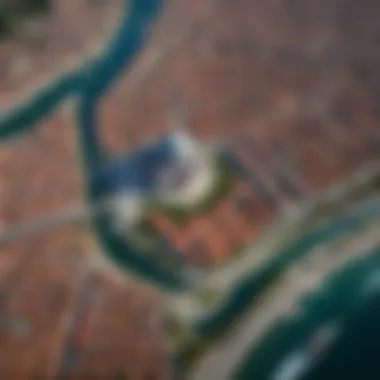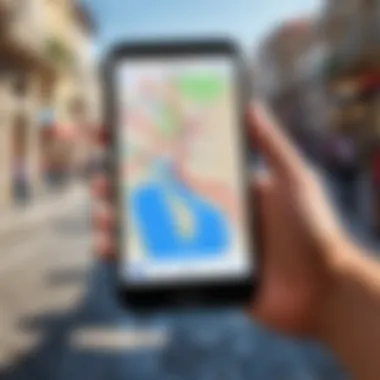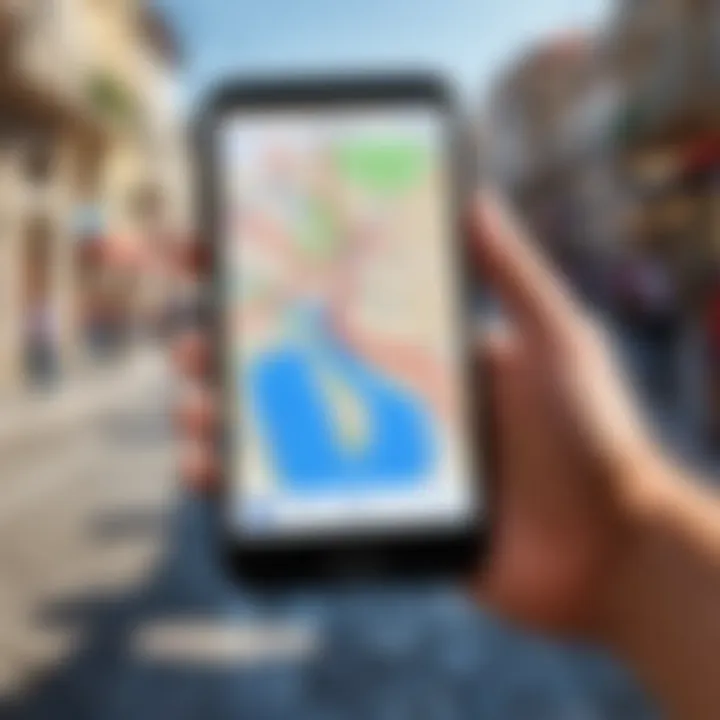Interactive Map of Istanbul: Your Ultimate Travel Guide


Intro
Istanbul, a city where history meets modernity, presents countless opportunities for exploration. An interactive map can serve as a valuable tool for both newcomers and seasoned travelers alike. It brings forth a digital format that enhances the experience of navigating through the rich tapestry of Istanbul's streets and landmarks.
An interactive map not only provides directions but also integrates multimedia elements, including photographs, user reviews, and historical context. This feature augments the classic travel experience by granting immediate access to insights that may typically require extensive research. As urban navigation continues to evolve with technology, understanding how to utilize these maps becomes essential for an enriching visit to Istanbul.
Popular Destinations
Exploring Istanbul's varied landscape begins with understanding its must-visit sites. The city boasts a mix of historical and contemporary attractions, each representing different facets of its vibrant culture.
- Unique destinations for exotic travels
Istanbul’s allure lies in its diverse districts. Areas like Sultanahmet are known for crucial historical sites such as the Hagia Sophia and the Blue Mosque. Meanwhile, Kadıköy offers a taste of local life, with bustling markets and modern cafes. - Comfortable spots for family leisure
For families, places like Miniatürk provide a compact view of Turkey's architectural wonders, making it educational and entertaining. Parks like Emirgan Park offer ample space for picnics and relaxation, enhancing the family's travel experience.
Preparing for Travel
Before embarking on a journey to Istanbul, preparation is key. An interactive map can aid this process significantly.
- Tips for choosing your itinerary
It is advisable to first identify interests. Are historical sites the main attraction, or is it the culinary experiences? An interactive map can help visualize the best routes that connect these interests efficiently. - How to pack: useful recommendations
Packing for Istanbul requires thoughtful consideration of the climate and activities. Besides clothing, don’t forget essentials like comfortable walking shoes and a portable charger for your device to ensure access to your interactive map throughout the day.
Remember, every corner of Istanbul has a story to tell, and it is vital to be prepared to uncover them.
Navigating the city can thus be transformed into a seamless experience when armed with the right tools and insights, making an interactive map indispensable for any traveler.
Preface to Interactive Mapping
Interactive mapping has become a vital tool in navigating urban environments, providing detailed information and enhancing the user experience. For travelers, especially in a historically rich city like Istanbul, having access to an interactive map can make all the difference. It allows users to visualize their surroundings, discover landmarks, and plan their routes effectively.
Definition and Purpose
Interactive mapping refers to digital maps that enable user interaction. Unlike traditional static maps, these maps can display data in real time, offer layers of information, and allow for customization. The primary purpose of interactive maps is to help users find their way, but they also serve broader functions, such as educational tools and cultural representations. For visitors to Istanbul, an interactive map can tailor the exploration to their interests, whether they seek cultural sites, dining options, or public transport routes.
Evolution of Mapping Technology
The journey of mapping technology is fascinating. From early paper maps to advanced GPS systems, the methods we use to navigate have drastically transformed. In recent years, the introduction of smart devices and applications has revolutionized how people interact with their environment. Maps have transitioned from merely being navigation aids to rich platforms filled with multimedia content. Companies like Google have pioneered these advancements by integrating satellite imagery, street views, and user-generated content. This evolution has not only enhanced the user experience but has also democratized access to geographical information. In a place like Istanbul, this means that tourists and locals alike can easily navigate the city's complex layout without feeling overwhelmed.
Why Use an Interactive Map in Istanbul?
Navigating a vibrant and historical city like Istanbul can be daunting without the right tools. An interactive map becomes essential for tourists and locals alike. This technology allows users to explore the city with ease, locate landmarks, and understand their surroundings better. Moreover, interactive maps can bring an added layer of information, enhancing the travel experience beyond mere navigation.
Benefits for Tourists
For tourists, the advantages of using an interactive map in Istanbul are numerous. First, it provides a simple way to orient oneself in the city. Whether you are close to the famous Hagia Sophia or wandering through the bustling streets of the Grand Bazaar, having a map at your fingertips helps alleviate the potential stress of getting lost.
Additionally, interactive maps offer more than just directions. They can highlight points of interest, local dining options, and transportation hubs. For example, while visiting the Topkapi Palace, a tourist might also discover nearby cafes or shops they might not have found otherwise. Such functionalities turn the map into a comprehensive travel companion.
In terms of technology, many interactive maps integrate user-generated content like reviews and recommendations. This feature can be invaluable, allowing tourists to gauge the popularity of attractions or read firsthand accounts from other visitors. Thus, tourists can make informed decisions about where to visit and what to skip, tailoring their experience to their interests.
Accessibility Features
Accessibility is another critical aspect where interactive maps shine. Many platforms now include features specifically designed for individuals with disabilities. This can include wheelchair-accessible routes or information on transportation that accommodates various needs. By providing these options, interactive maps ensure that all travelers can enjoy what Istanbul has to offer.
The user interface of many interactive maps has also evolved. They often feature options to enlarge text or change color contrasts, supporting users with visual impairments. Some applications even allow users to listen to directions, which can be beneficial for various types of travelers.
In summary, using an interactive map in Istanbul greatly enhances the travel experience. It provides valuable navigation support, extensive information, and accessibility features that cater to every kind of traveler. As technology continues its advance, the relevance of these maps in urban exploration will only grow.
Key Features of Interactive Maps
Interactive maps have become essential tools in urban navigation, especially in a complex city like Istanbul. Their multidimensional capabilities enhance user experience and offer several advantages that standard maps do not provide. Understanding these key features is important for anyone looking to explore the city effectively.


Layered Information
One primary feature of interactive maps is the ability to present layered information. This allows users to toggle various layers of data according to their interests. For example, tourists can display historical landmarks, public transport routes, and restaurant locations all at once, or choose to view them one at a time. This kind of flexibility provides a more nuanced understanding of the area.
Additionally, layered information on interactive maps can show cultural sites, parks, and other community features that one might otherwise overlook. Users gain better context about what to see or where to go, which is particularly useful when navigating a historically rich city such as Istanbul.
Real-Time Updates
Another significant advantage is the integration of real-time updates. Interactive maps often sync with online databases to provide current information about traffic, public transport schedules, and even crowd levels at popular attractions.
This feature can drastically improve trip planning. If a tourist realizes that a particular metro line is experiencing delays, they can quickly and easily adjust their route. Furthermore, being aware of crowds at landmarks can influence timing decisions, helping to avoid long waits during peak periods. Such dynamic data keeps the user informed and makes for more efficient travel.
User Customization Options
User customization is also an invaluable feature of interactive maps. Many platforms allow users to shape their experience by marking favorite spots, creating custom itineraries, or saving specific routes. This makes it easier to plan visits to diverse attractions throughout Istanbul.
For instance, a traveler might want to explore art galleries one day and try local cuisine the next. By utilizing customization tools, the user can adjust their map view to include only relevant points of interest. This level of control makes the user feel empowered, allowing them to focus on areas they genuinely care about.
"Interactive maps transform traditional navigation into personalized experiences, catering to individual preferences and real-time adjustments."
Overall, these key features—layered information, real-time updates, and user customization—enhance the functionality of the interactive maps, making them a vital tool for both tourists and locals in Istanbul.
Cultural and Historical Landmarks of Istanbul
Istanbul’s cultural and historical landmarks hold significant importance in understanding the city's rich heritage and diverse history. These landmarks offer tourists insights into the city’s past, combined with their architectural beauty. The interactive map proves essential in navigating these sites, making them more accessible to visitors. By utilizing such maps, travelers can efficiently explore both prominent attractions and hidden treasures, enriching their overall experience.
Top Attractions to Highlight
Hagia Sophia
Hagia Sophia stands as an iconic monument, showcasing a blend of architectural ingenuity and historical significance. Originally constructed as a cathedral, it later served as a mosque and is now a museum. The building's massive dome and intricate mosaics are key characteristics that attract millions of visitors each year. Using an interactive map, one can easily find Hagia Sophia's location and nearby amenities, which enhances the visiting experience. However, the site's popularity may lead to overcrowding, especially during peak seasons.
Topkapi Palace
Topkapi Palace is another essential site in Istanbul, symbolizing the grandeur of the Ottoman Empire. This extensive palace complex offers visitors a glimpse into the splendor of royal life, complete with intricate courtyards and stunning views of the Bosphorus. The unique feature of Topkapi Palace is its vast collection of artifacts, including the famous Topkapi Dagger and the Holy Mantle. Through interactive maps, tourists can plan their routes around the extensive grounds, mitigating the risk of missing out on important exhibits. Nonetheless, navigating such a large site can be challenging for some.
Grand Bazaar
The Grand Bazaar represents one of the largest and oldest covered markets in the world. This bustling hub is famous for its vibrant atmosphere and wide variety of goods, including textiles, jewelry, and spices. The interactive map can facilitate the exploration of this labyrinthine marketplace, helping visitors identify specific shops and vendors. While the Grand Bazaar is undoubtedly a treasure trove for shoppers, it may also become overwhelming due to its size and crowds.
Lesser-Known Gems
Basilica Cistern
The Basilica Cistern is an underground marvel, providing a respite from the bustling city above. This ancient reservoir showcases impressive columns and a unique atmosphere, making it a captivating site for those interested in history and architecture. Utilizing interactive maps, visitors can discover its location easily, allowing spontaneous stops during their explorations. However, the low light inside may not suit everyone.
Chora Church
Chora Church, known for its exquisite mosaics and frescoes, is a testament to Byzantine artistry. This lesser-known gem offers a quieter experience compared to the more famous landmarks, allowing visitors to appreciate its beauty away from the crowds. An interactive map assists tourists in finding Chora Church, which may be slightly off the beaten path. The disadvantage can be its more limited visiting hours.
Süleymaniye Mosque
Süleymaniye Mosque is an architectural wonder that merges grandeur with tranquility. It serves as a functioning mosque, providing a space for prayer and reflection. Its vast courtyard offers stunning views of the Golden Horn. The interactive map is beneficial in locating the mosque and understanding its historical context. The downside is that tourists need to observe proper etiquette while visiting, which might limit their stay.
Navigating the City with Interactive Maps
In the era of technology, navigating through a bustling metropolis like Istanbul can feel overwhelming. However, interactive maps offer a solution that can transform the experience of getting around the city. These digital tools not only assist in identifying locations but also enhance the way users engage with the rich tapestry of its historical and cultural sites. Understanding how to make the most of these navigation aids is crucial for anyone visiting Istanbul, whether they are seasoned travelers or first-time explorers.
Planning Your Route


For any traveler, having a well-structured plan can make the difference between an enjoyable outing and a stressful experience. Interactive maps excel in helping users plan their routes effectively. With features that allow individuals to input their starting point and desired destination, users can visualize the most efficient pathways. This can save time and reduce frustration, particularly in a city with heavy traffic like Istanbul.
Users can also view details such as walking distances, alternative routes, and estimated travel times. This level of detail allows for a more tailored travel experience, accommodating specific needs or preferences. For example, someone may prefer to avoid steep hills or choose paths that pass by certain landmarks. By providing this information, interactive maps empower travelers to make better-informed decisions that can enhance their journey.
Public Transportation Integration
Another significant advantage of interactive maps is their integration with public transportation systems in Istanbul. The city has an extensive and multi-faceted public transport network, including buses, trams, and ferries. Travelers can benefit immensely from maps that incorporate real-time public transportation schedules and routes.
Using tools like Google Maps, individuals can seamlessly switch between different modes of transport, discovering options that fit their specific needs. For instance:
- Bus Timetables: View upcoming bus arrivals and their respective routes.
- Tram Connections: Identify tram lines that connect major tourist attractions.
- Ferry Services: Access timely information on ferry schedules across the Bosphorus.
Moreover, some interactive maps provide features that allow users to plan routes that include multiple types of transport, optimizing their travel times and experiences. This connectivity makes exploring Istanbul not only accessible but also enjoyable, ensuring travelers arrive at their intended destinations with ease.
Travel Tip: Always check for the latest updates on public transportation as schedules may change, especially during peak tourist seasons.
In short, interactive maps play a pivotal role in navigating Istanbul. They assist in planning routes effectively and integrating public transport into travel plans, making the city more approachable for everyone.
Popular Interactive Map Platforms
Exploring Istanbul effectively requires an understanding of various interactive map platforms. These platforms play a crucial role in helping tourists navigate the city seamlessly. They not only enhance the travel experience but also provide valuable information about landmarks, public transportation, and local amenities. Choosing the right mapping tool can drastically affect your exploration efficiency and overall satisfaction. Below are three leading platforms that cater to diverse needs in Istanbul.
Google Maps
Google Maps stands out as the most widely used mapping application globally, including in Istanbul. Its strength lies in its comprehensive data, user-friendly interface, and extensive features.
Key Benefits of Google Maps:
- Detailed Local Information: Google Maps offers extensive information on businesses, restaurants, and various attractions, ensuring tourists have access to essential resources.
- Real-Time Navigation: It provides real-time traffic updates and directions, enabling users to find the quickest routes to their destinations. This can be invaluable in a vibrant city where traffic can change rapidly.
- User Reviews and Photos: The integration of user-generated content allows for personal insights into places. Travelers can view photos and read reviews before heading to a specific location.
Here WeGo
Here WeGo is an alternative to Google Maps that emphasizes offline functionality. Its design caters to users who might not have constant internet access, making it especially useful in a city like Istanbul where signal can be spotty in some areas.
Key Features of Here WeGo:
- Offline Maps: Users can download maps for use without an internet connection. This feature is crucial for navigating areas with limited service.
- Public Transport Options: Here WeGo includes public transport schedules and routes, making it easy for travelers to opt for buses or trams.
- Simple Interface: The application is designed for easy navigation, ensuring users can quickly find relevant information.
Local Map Applications
Local map applications can offer unique insights into Istanbul’s different neighborhoods. While larger platforms like Google Maps and Here WeGo provide broad coverage, local apps often have niche features that cater specifically to the city’s unique landscape.
Benefits of Using Local Map Applications:
- Cultural Relevance: Many local apps highlight historical sites and cultural districts, offering context that larger applications may overlook.
- Specialized Content: These applications may include features like local events, ongoing exhibitions, or street fairs that a tourist might wish to attend.
- Community Engagement: Local maps may foster a sense of community, encouraging users to engage with their surroundings in more meaningful ways.
The choice of an interactive map platform can greatly impact your experience in Istanbul. Whether utilizing a well-known service like Google Maps, seeking reliability with Here WeGo, or engaging with local applications tailored for the city, it's essential to understand the strengths and limitations of each option. Consider your needs—whether it's real-time updates, offline accessibility, or local insights—as you prepare for your journey.
User Reviews and Feedback
Importance of User Experience
User experience stands as a cornerstone in the realm of interactive maps, especially in a city as multifaceted as Istanbul. This concept encapsulates how travelers interact with a mapping service and the ease with which they can navigate the city's intricate layout. In the context of this article, user experience is pivotal because it directly informs potential users about the effectiveness of the maps available. When reviewing an interactive map, factors such as usability, layout, and clarity all play critical roles in shaping user satisfaction.
Moreover, understanding user sentiment allows developers to refine features based on real experiences. If users find that a specific map is difficult to navigate, the developers can take this feedback to enhance its functionality. Positive user reviews, on the other hand, can signal well-designed features that cater to travelers’ needs, thus encouraging new users to consider those maps for their exploration of Istanbul. Ultimately, a good user experience fosters confidence among travelers and enhances their journey through the city.
Analyzing Common Feedback


One of the methods to gauge the effectiveness of interactive maps is to analyze common feedback from users. Such reviews provide a wealth of information, revealing patterns in user behavior and preferences. For instance, travelers often express the importance of accurate data, particularly when seeking directions or information about various landmarks.
"I love how Google Maps shows real-time public transportation options! It saved me time while exploring the city."
Common feedback elements often include:
- Navigation Ease: Users typically note whether the map is intuitive and straightforward. Complex interfaces can dissuade travelers from using a map effectively.
- Data Accuracy: Reviews frequently highlight the reliability of information, such as operating hours of attractions and updated routes for public transport.
- Customization Features: Travelers appreciate maps that allow personal routes or saved favorites, tailoring experiences to their unique preferences.
Incorporating feedback analysis informs developers about what areas require improvement. This approach fosters a user-centered design, ultimately making interactive maps more beneficial for everyone navigating the vibrant streets of Istanbul. Understanding varied experiences helps ensure that future users can rely on these resources to enhance their travel experience.
Challenges and Limitations of Interactive Maps
While interactive maps present significant advancements in navigation and exploration, they are not without their challenges and limitations. Understanding these aspects is essential for travelers who rely on them to navigate the intricate streets and cultural landscapes of Istanbul. Potential issues can detract from the user experience and influence how effectively one can interact with and utilize these resources.
Technical Issues
Technical difficulties can arise in various forms when using interactive maps. For example, connectivity problems may hinder access to real-time data, leaving users stranded without updated information. Poor internet service, which can be common in crowded tourist areas of Istanbul, may also lead to slow loading times or incomplete maps. In some cases, users may find that their devices are not compatible with certain interactive map applications. Limited battery life is another concern, as the continuous use of GPS and map applications drains battery power quickly. Therefore, it is wise for travelers to prepare their devices in advance, ensuring they have backup charging options and offline maps whenever possible.
Data Accuracy and Updates
The accuracy of the data presented on interactive maps is another critical consideration. Interactive maps rely on various data sources, and the frequency of updates can vary significantly. Locations may change, new attractions may emerge, or renovations may alter familiar sites. If maps do not reflect these changes accurately, they may mislead users.
Travelers should always prioritize checking multiple sources to confirm the information they find. This practice helps to mitigate the potential for confusion caused by outdated data.
Moreover, user-generated content can impact the reliability of reviews or suggestions found on interactive maps. While local insights can be valuable, they may also reflect individual experiences that do not represent broader consensus. Thus, travelers should approach such information with a critical perspective, ensuring they assess the credibility of reviews and feedback before relying on them.
Future of Interactive Mapping in Tourism
Interactive mapping is revolutionizing how tourists navigate urban landscapes. This transformation is especially evident in cities with rich histories and complex layouts, like Istanbul. As we move forward, the future of interactive mapping in tourism is poised to bring even more sophisticated tools and features, making the travel experience more accessible and enjoyable. Understanding these developments is crucial for tourists who wish to enhance their journeys.
Emerging Trends
Several notable trends are shaping the future of interactive mapping in tourism. One of the most exciting is the integration of artificial intelligence. AI can analyze user behavior and preferences, offering personalized recommendations. For instance, as a user explores Istanbul's interactive map, suggested routes and attractions can be tailored to their interests, improving overall experiences.
In addition, the rise of mobile technology is enhancing accessibility. More travelers rely on smartphones for navigation, driving the need for mobile-responsive interactive maps. These maps enable users to receive real-time information about nearby attractions, dining options, and local events, making it easier for them to immerse themselves in Istanbul's cultural tapestry.
Another trend is the emphasis on sustainable tourism. Interactive mapping platforms are incorporating features that highlight eco-friendly options. Users can discover green areas, public transportation routes, and sustainable accommodations, aiding their quest for responsible travel.
Impact of Virtual Reality and Augmented Reality
The impact of virtual reality (VR) and augmented reality (AR) on interactive mapping cannot be overstated. These technologies provide immersive experiences that engage users on a deeper level. For example, a VR tour of Istanbul's historic sites can be accessed through an interactive map. These experiences allow travelers to preview locations before visiting, bridging the gap between the virtual and the physical world.
With AR, users can view historical contexts or information overlaid on their actual environment through their devices. As someone walks around Sultanahmet, they may point their phone at Hagia Sophia and receive real-time insights about its architectural features, historical significance, and nearby dining options. This integration not only enhances understanding but also enriches the overall travel experience.
"The future of interactive mapping will not just guide us but will also immerse us in the culture and history of the places we visit."
The continuous evolution of these technologies indicates that interactive maps will become increasingly essential in tourism. As these innovations unfold, they provide travelers with more tools to explore, learn, and appreciate destinations, making interactive mapping a vital part of the travel industry.
Ending
The conclusion serves as the final segment in understanding the various aspects of interactive maps tailored to Istanbul. This section is instrumental as it brings together all the ideas discussed throughout the article, highlighting the significance of these tools in modern navigation. Interactive maps are not merely a technological convenience; they represent a shift in how travelers engage with urban environments.
By summarizing the key elements, readers gain a clear perspective on the benefits, challenges, and future potential of such resources. The use of interactive mapping can profoundly enhance the experience of both seasoned tourists and first-time visitors. Constraints and advantages related to the practical applications of these maps are essential insights that help in forming educated travel plans.
Summary of Key Points
- Importance of Navigation: Interactive maps enhance navigation, making it efficient and user-friendly for diverse users.
- Cultural Engagement: Highlighting landmarks—from iconic sites like Hagia Sophia to hidden treasures like the Basilica Cistern—allows users to enjoy a richer travel experience.
- Technology Integration: The evolution of mapping tools, including apps and real-time updates, reflects changing consumer expectations and tech capabilities.
- User Feedback: Understanding user experiences is crucial for improving map reliability and effectiveness.
- Future Trends: Developments in virtual and augmented reality promise to take interactive mapping further, promising an even deeper way to explore Istanbul.
Final Thoughts on Interactive Mapping
Interactive mapping technology has become integral in the travel industry. For Istanbul, it offers a unique combination of historical richness and modern convenience. Visitors can easily access necessary information right from their devices. The benefits include reduced navigation time, better understanding of local transit systems, and tailored exploration of attractions.
As travel preferences continue to evolve, the reliance on interactive maps will likely increase. Understanding their role can encourage travelers to utilize them effectively.
In summary, the interactive maps of Istanbul not only simplify navigation but also enrich the overall travel experience, blending technology with cultural discovery.







